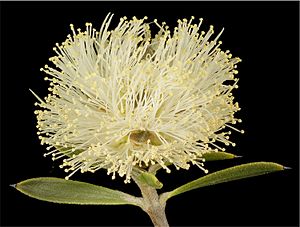Conothamnus trinervis facts for kids
Quick facts for kids Conothamnus trinervis |
|
|---|---|
 |
|
| In Forrestfield | |
| Scientific classification | |
| Genus: |
Conothamnus
|
| Species: |
trinervis
|
| Synonyms | |
|
|
Conothamnus trinervis is a special kind of plant, a shrub that belongs to the Myrtaceae family. This family includes plants like eucalyptus trees. This shrub is found only in Western Australia, which means it is "endemic" there. It has strong, thick stems, leaves with a sharp tip, and usually cream-colored flowers.
Contents
What is Conothamnus trinervis?
This plant is a shrub that can grow upright or spread out. It usually reaches a height of about 0.15 to 1.5 metres (0.5 to 4.9 ft). Its branches are thick and stiff.
What it Looks Like
The leaves of Conothamnus trinervis often grow in pairs opposite each other. Sometimes, they grow in groups of three, forming a circle around the stem, which is called a whorl. These leaves are about 1–4 cm (0.39–1.57 in) long. They have three clear veins and a sharp point at the very end.
The flowers are usually yellow, cream, or white. Sometimes, they can even be purple! They grow in round clusters about 3 cm (1.2 in) wide. Each group of three flowers has a special leaf-like part called a bract at its base. The flowers themselves have five sepals (which protect the bud) and five petals. Other types of Conothamnus plants only have two flowers in a group and no petals. Conothamnus trinervis blooms between August and October.
How Conothamnus trinervis Got Its Name
The plant Conothamnus trinervis was first officially described in 1839. This was done by a person named John Lindley. He wrote about it in a book called A Sketch of the Vegetation of the Swan River Colony.
The second part of its name, trinervis, tells us something important about the plant. It comes from two Latin words. "Tri-" means "three," and "nervus" means "sinew" or "tendon." So, trinervis means "three-veined," which refers to the three veins on its leaves.
Where Conothamnus trinervis Grows
This shrub is found along the west coast of Western Australia. You can see it in areas like the Swan Coastal Plain, the Mid West, and the Wheatbelt regions. It likes to grow in sandy soils that have a lot of iron, in a type of plant community called kwongan. Kwongan is a special kind of shrubland found in Western Australia.

